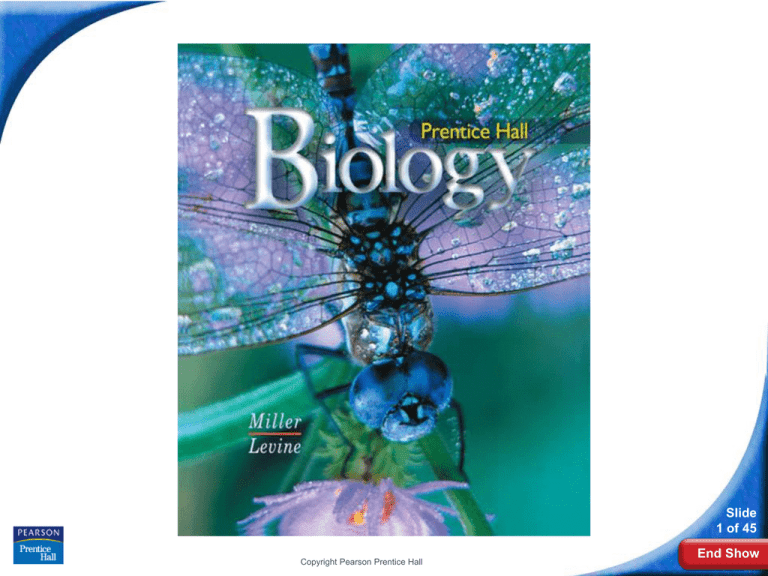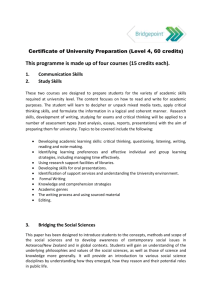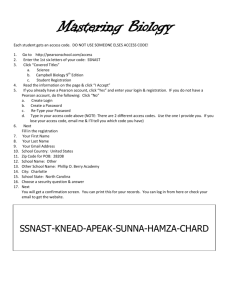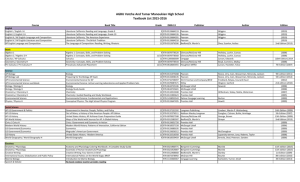
Biology
Slide
1 of 45
Copyright Pearson Prentice Hall
End Show
1-3 Studying Life
Slide
2 of 45
Copyright Pearson Prentice Hall
End Show
1-3 Studying Life
Characteristics of Living Things
What are some characteristics of living
things?
Slide
3 of 45
Copyright Pearson Prentice Hall
End Show
1-3 Studying Life
Characteristics of Living Things
Living things share the following
characteristics:
• made up of units called cells
• reproduce
• based on a universal genetic code
• grow and develop
• obtain and use materials and energy
• respond to their environment
• maintain a stable internal environment
• change over time
Slide
4 of 45
Copyright Pearson Prentice Hall
End Show
1-3 Studying Life
Big Ideas in Biology
Big Ideas in Biology
Science as a Way of Knowing
Science is not just a list of “facts.”
The job of science is to use observations,
questions, and experiments to explain the natural
world.
Slide
5 of 45
Copyright Pearson Prentice Hall
End Show
1-3 Studying Life
Big Ideas in Biology
Interdependence in Nature
All forms of life on Earth are connected together
into a biosphere, which literally means “living
planet.”
Slide
6 of 45
Copyright Pearson Prentice Hall
End Show
1-3 Studying Life
Big Ideas in Biology
Matter and Energy
Matter serves as nutrients to build body structure
and energy to fuel the processes of life.
Slide
7 of 45
Copyright Pearson Prentice Hall
End Show
1-3 Studying Life
Big Ideas in Biology
Cellular Basis of Life
Organisms are composed of one or more cells,
which are the smallest units that can be
considered fully alive.
Slide
8 of 45
Copyright Pearson Prentice Hall
End Show
1-3 Studying Life
Big Ideas in Biology
Information and Heredity
Genetic code is common, with minor variations, to
every organism on Earth.
That information, carried in DNA, is copied and
passed from parents to offspring.
Slide
9 of 45
Copyright Pearson Prentice Hall
End Show
1-3 Studying Life
Big Ideas in Biology
Unity and Diversity of Life
All living things are fundamentally alike at the
molecular level, even though life takes an almost
unbelievable variety of forms.
Slide
10 of 45
Copyright Pearson Prentice Hall
End Show
1-3 Studying Life
Big Ideas in Biology
Evolution
In biology, evolution, or the change in living things
through time, explains inherited similarities as well
as the diversity of life.
Slide
11 of 45
Copyright Pearson Prentice Hall
End Show
1-3 Studying Life
Big Ideas in Biology
Structure and Function
Structures evolve in ways that make particular
functions possible, allowing organisms to adapt to
a wide range of environments.
Slide
12 of 45
Copyright Pearson Prentice Hall
End Show
1-3 Studying Life
Big Ideas in Biology
Homeostasis
An organism’s ability to maintain a relatively
stable internal environment.
Slide
13 of 45
Copyright Pearson Prentice Hall
End Show
1-3 Studying Life
Big Ideas in Biology
Science, Technology, and Society
Science seeks to provide useful information, but
only a public that truly understands science and
how it works can determine how that information
should be applied.
Slide
14 of 45
Copyright Pearson Prentice Hall
End Show
1-3 Studying Life
Branches of Biology
A Few Branches of Biology
• Zoologists
• Botanists
• Paleontologists
• Cell Biologists
• Geneticists
• Microbiologists
• Ecologists
Copyright Pearson Prentice Hall
Slide
15 of 45
End Show
1-3 Studying Life
Branches of Biology
How can life be studied at different levels?
Slide
16 of 45
Copyright Pearson Prentice Hall
End Show
1-3 Studying Life
Branches of Biology
Some of the levels at which life can be
studied include:
• molecules
• cells
• organisms
• populations
• communities
• biomes
• the biosphere
Slide
17 of 45
Copyright Pearson Prentice Hall
End Show
1-3 Studying Life
Branches of Biology
Biosphere
The part of Earth that contains all ecosystems
Slide
18 of 45
Copyright Pearson Prentice Hall
End Show
1-3 Studying Life
Branches of Biology
Ecosystem
Community and its nonliving surroundings
Hawk, snake, bison, prairie dog, grass, stream, rocks, air
Slide
19 of 45
Copyright Pearson Prentice Hall
End Show
1-3 Studying Life
Branches of Biology
Community
Populations that live together in a defined area
Hawk, snake, bison, prairie dog, grass
Slide
20 of 45
Copyright Pearson Prentice Hall
End Show
1-3 Studying Life
Branches of Biology
Population
Group of organisms of one type that live in the same
area
Bison herd
Slide
21 of 45
Copyright Pearson Prentice Hall
End Show
1-3 Studying Life
Branches of Biology
Organism
Individual living thing
Bison
Copyright Pearson Prentice Hall
Slide
22 of 45
End Show
1-3 Studying Life
Branches of Biology
Groups of Cells
Tissues, organs, and organ systems
Nervous tissue
Brain
Nervous system
Slide
23 of 45
Copyright Pearson Prentice Hall
End Show
1-3 Studying Life
Branches of Biology
Cells
Smallest functional unit of life
Nerve cell
Slide
24 of 45
Copyright Pearson Prentice Hall
End Show
1-3 Studying Life
Branches of Biology
Molecules
Groups of atoms; smallest unit of most chemical
compounds
Water
DNA
Slide
25 of 45
Copyright Pearson Prentice Hall
End Show
1-3 Studying Life
Biology in Everyday Life
Biology in Everyday Life
More than any other area of study, biology touches
your life every day.
How?
Slide
26 of 45
Copyright Pearson Prentice Hall
End Show
1-3
Click to Launch:
Continue to:
- or -
Slide
27 of 45
End Show
Copyright Pearson Prentice Hall
1-3
An increase in size is known as
a. growth.
b. metabolism.
c. development.
d. differentiation.
Slide
28 of 45
End Show
Copyright Pearson Prentice Hall
1-3
Which of the following is NOT a characteristic of
all living things?
a. use of energy
b. made of cells
c. stable internal environment
d. need for oxygen
Slide
29 of 45
End Show
Copyright Pearson Prentice Hall
1-3
Which of the following are branches in the study
of biology?
a. cells, tissues, organs, and organisms
b. botany, cell biology, ecology, and zoology
c. populations, communities, and ecosystems
d. the genetic code, evolution, and the
biosphere
Slide
30 of 45
End Show
Copyright Pearson Prentice Hall
1-3
The genetic code is carried in
a. Water.
b. DNA.
c. proteins.
d. soil.
Slide
31 of 45
End Show
Copyright Pearson Prentice Hall
1-3
Which of the following shows the levels of
organization in correct order from the simplest to
the most complex?
a. organisms, cells, populations, molecules,
ecosystems
b. ecosystems, populations, organisms, cells,
molecules
c. molecules, cells, organisms, populations,
ecosystems
d. molecules, organisms, cells, populations,
ecosystems
Slide
32 of 45
End Show
Copyright Pearson Prentice Hall
END OF SECTION






